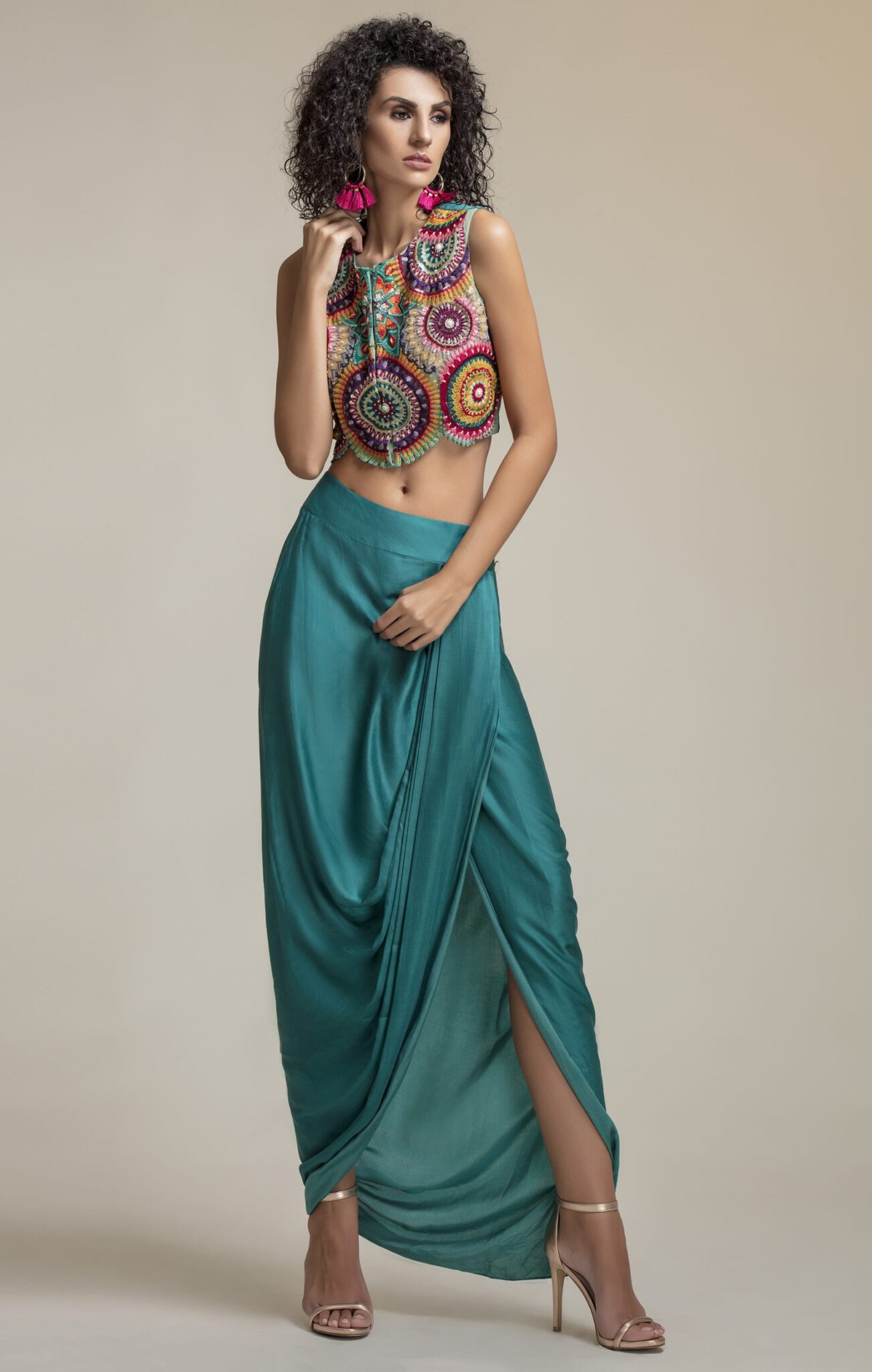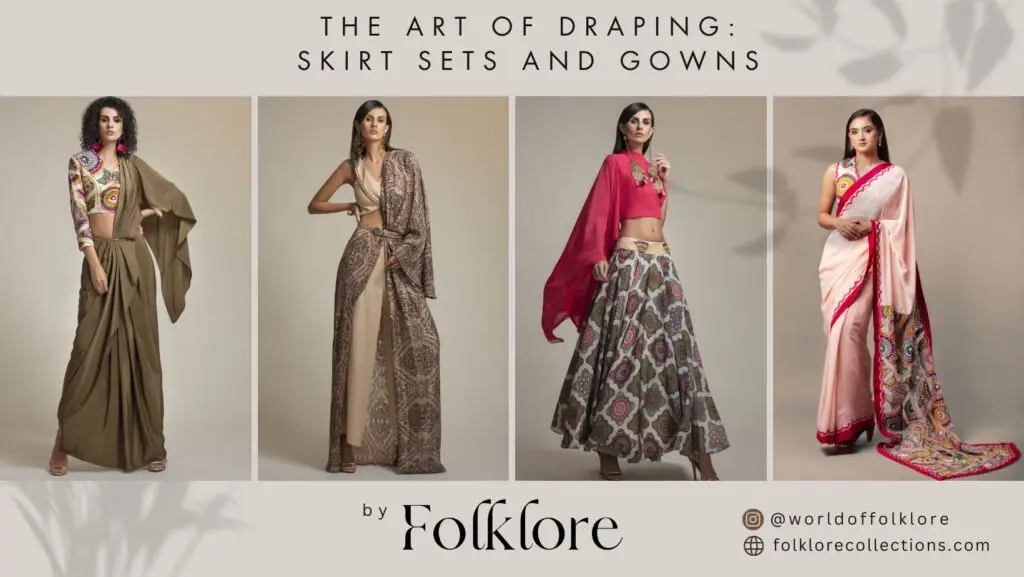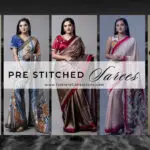Discover the art of draping with the latest skirt sets and gowns with the world of Folklore. Draping has been part of our world since ancient civilizations like Egyptian, Greek, Roman, and more. The draping style evolved with every passing period, and we saw changes in styles and material and technological advancements. One of the most old-age techniques is still used in our latest fashion statements in the form of drape skirt sets and drape gown collections. In this blog, we will learn about the draping style with Folklore’s vision and also explain how the draping style has evolved since ancient civilizations to the latest styles.

What is Draping?
Draping creates clothing patterns directly on a dress form or mannequin rather than using a flat pattern on paper. It involves manipulating and positioning fabric in a three-dimensional form to achieve the desired garment shape. Draping is an essential skill in fashion design, allowing designers to visualize and experiment with different silhouettes, styles, and fabric drapes. Designers choose a fabric suitable for the intended garment. The fabric’s choice dramatically influences how it drapes and falls on the body. The dress form or mannequin is prepared with a base layer, often muslin or another lightweight fabric, to provide a neutral foundation for the draping process. Using the selected fabric, designers begin pinning and manipulating the material directly on the dress form. This step involves creating folds, tucks, and pleats to shape the fabric around the body’s contours or the desired garment form.
Designers continuously refine and adjust the fabric throughout the draping process to achieve the desired design. It may involve experimenting with different draping techniques, considering the grain of the fabric, and ensuring that the garment falls and moves in a way that complements the intended design. Once satisfied with the draped design, designers mark key points and lines on the fabric. These markings guide the transfer of the draped design onto a flat pattern for production.
History of Draping
The history of draping in fashion is a fascinating journey that spans centuries and encompasses various cultures and civilizations. As a garment construction technique, draping has evolved from simple cloth wraps to sophisticated and intricate designs.
Ancient Civilizations
Egyptians were amongst the first practitioners of draping. Lightweight fabrics like linen were used to create draped garments such as the kalasiris for women and the shandy for men. Ancient Greeks and Romans elevated draping as an art form. Greek chitons and Roman togas were iconic draped garments that varied in style based on social status.
Byzantine and Medieval Period
The Byzantine Empire continued the tradition of draping, with a focus on luxurious fabrics and intricate embellishments. Draping in medieval Europe evolved into garments like the surcoat and houppelande, which featured layers and drapes that reflected the hierarchical structure of society.
Renaissance and Baroque Eras
The Renaissance saw a revival of interest in classical aesthetics, influencing fashion with draped garments that highlighted the body’s natural form. Meanwhile, the Baroque period embraced opulence and grandeur. Draped garments adorned with lace, ribbons, and ornate details became a symbol of wealth and status.
18th and 19th Centuries
Neoclassical ideals brought a return to simplicity in draping, inspired by ancient Greek and Roman styles. Flowing muslin fabrics were draped to create columnar silhouettes, reflecting a desire for classical purity. The Victorian era introduced a combination of draped and structured garments. Crinolines and bustles created exaggerated shapes while draping persisted in shawls and overskirts.
The early 20th century
the 1920s marked a shift towards more relaxed and unstructured silhouettes. Draped dresses with straight cuts and loose fits became popular, influenced by the Art Deco movement and the liberated spirit of the “flapper.”
Mid to late 20th Century
Draping continued to be a hallmark of haute couture, with designers like Christian Dior and Cristobal Balenciaga incorporating draped elements into their iconic designs. As fashion became more casual in the latter half of the 20th century, draping became everyday wear. Draped blouses, dresses, and skirts became famous for combining comfort with style.
Experimenting and Technological advancements
Technological advancements and a globalized fashion industry have allowed for innovative approaches to draping, with 3D printing and unconventional materials entering the scene.
World of Folklore brings Draping styles
Indian draping styles are integral to the country’s rich and diverse cultural heritage. Each region in India has its distinct draping style, which often reflects the local culture, climate, and historical influences. Folklore wants to bring contemporary draping styles inspired by the Indian cultural heritage. Here are two draping styles at Folklore that you can grab now-
Skirts – Drape skirt sets, with their fluid lines and graceful movements, symbolize understated elegance. Whether in midi or maxi lengths, designers experiment with various draping techniques to create skirts that are not only visually appealing but also comfortable and flattering. Combining tops and dresses in drape skirt sets allows for endless creativity. Designers play with asymmetry, layering, and innovative draping methods to craft sets that can transition effortlessly from day to night.

Gown – The draped gown collection represents a fusion of artistry, fabric manipulation, and design innovation. These gowns, characterized by their fluid and sculptural qualities, often feature intricate folds, pleats, and gathers that enhance the fabric’s drape and movement. The choice of fabric is crucial in creating the desired drape. Silks, chiffons, satins, and jersey knits are popular for draped gowns due to their ability to flow and move gracefully.
Saree and Dhoti set – The combination of a drape saree and dhoti set is a unique and innovative ensemble that beautifully blends traditional Indian elements. This modern interpretation of conventional attire reflects the evolving nature of fashion, where designers experiment with silhouettes and combinations to create fresh and exciting looks.
Final Thought
From the ancient civilizations to Byzantine to the current century, draping styles and methods have evolved and have produced an inspiring art form. Also, Indian draping styles are not just about clothing. They reflect cultural identity, regional diversity, and a connection to centuries-old traditions. As fashion evolves, these traditional draping styles continue to inspire contemporary designs, ensuring the timeless beauty of Indian attire. In this new era of fashion, draping is a versatile and ever-evolving technique. That reflects the values and advancements of contemporary society. With the World of Folklore, you can experience the latest style and technological advancements. The form of draped skirt sets and draped gown collections










